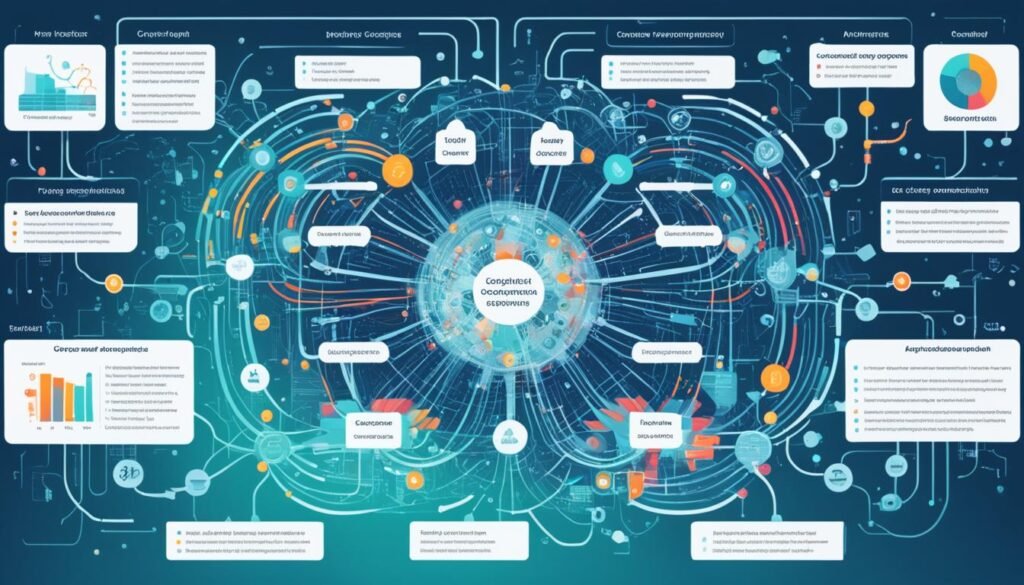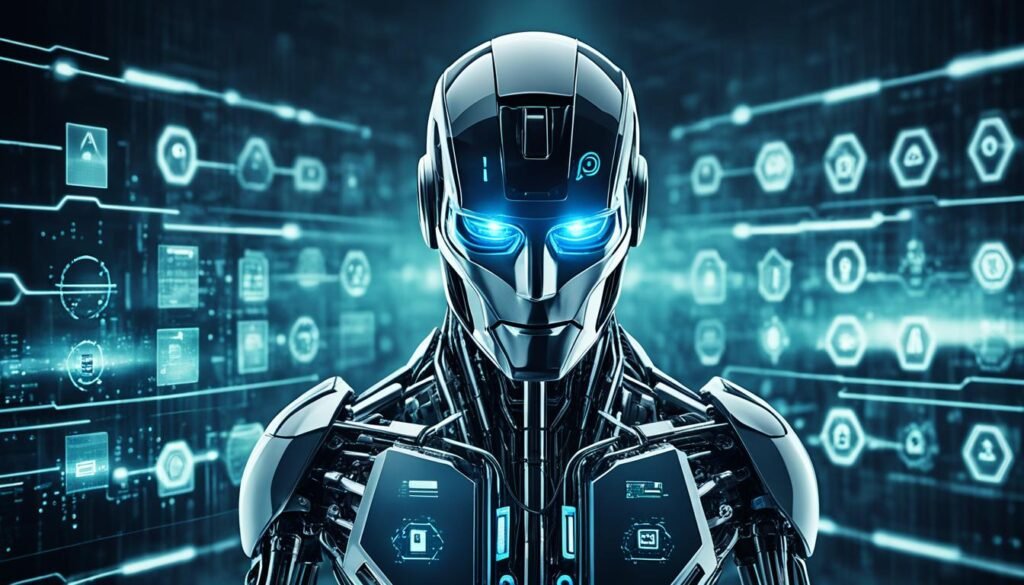Cybercrime is expected to cause $10.5 trillion USD in damages worldwide by 2025. As AI changes our world, making AI ethics and security key is crucial. This article talks about why it’s important to protect our digital future with AI and cybersecurity together.
AI and cybersecurity work together to keep our digital world safe. AI helps make cybersecurity better, and good cybersecurity keeps AI safe and reliable. This teamwork is key to fighting new cyber threats, like AI-powered malware like IBM’s DeepLocker.
Learning about AI ethics security helps you understand privacy and data protection, and how AI should be clear and open. It’s important to know about the risks of AI, like bias and discrimination, as we use more AI.
Key Takeaways
- Cybercrime is a growing threat, with projected global damages of $10.5 trillion USD annually by 2025.
- AI and cybersecurity have an interdependent relationship, with AI enhancing security operations and cybersecurity safeguarding AI systems.
- Principles of AI ethics security include privacy, data protection, transparency, and explainability.
- Ethical risks such as algorithmic bias and discrimination must be addressed to ensure responsible AI development.
- Secure data storage, privacy-preserving techniques, and regulatory frameworks are crucial for safeguarding AI systems and data.
Understanding how AI and cybersecurity work together helps you stay safe in the digital world. By following AI ethics and security rules, you can protect your digital future.
The Critical Nexus of AI and Cybersecurity
The ai cybersecurity world is always changing. It needs new and forward-thinking proactive cybersecurity plans. AI can look at huge amounts of data quickly. This helps spot risks early and stop them before they happen. By finding patterns that might mean a security issue, ai-powered cybersecurity tools help make our defenses stronger against new cyber threats.
Enhanced Security via Cybersecurity Driven by AI
AI threat detection and ai pattern analysis make automated cybersecurity better by handling simple tasks automatically. This lets people focus on harder tasks and lowers the chance of mistakes. Using ai cybersecurity is key to keeping our digital world safe and secure.
Automation and Efficiency in Cybersecurity Operations
The Department of Homeland Security’s Cybersecurity and Infrastructure Security Agency (CISA) has a roadmap for using AI in cybersecurity. It outlines five main areas to improve ai-powered cybersecurity and make things more efficient. President Biden wants DHS to protect U.S. networks and fight AI threats. He sees ai cybersecurity as vital for our digital future.
“CISA envisions a secure digital ecosystem supporting innovation and critical infrastructure services.”

| Line of Effort | Focus |
|---|---|
| 1 | Using AI tools ethically to strengthen cyber defense and critical infrastructure support |
| 2 | Assessing and assuring secure AI systems across stakeholders |
| 3 | Protecting critical infrastructure from malicious AI use and establishing collaboration for mitigation |
| 4 | Collaborating with interagency, international partners, and public communication on AI efforts |
| 5 | Expanding AI expertise within CISA’s workforce through education and recruitment |
CISA is key in making ai cybersecurity safer and more resilient. It helps protect our digital world from cyber threats. This puts CISA at the heart of using ai-driven cybersecurity to keep our digital infrastructure safe.
The Evolving Landscape of Cyber Threats
In today’s digital world, state and non-state actors are using advanced tools for cyber threats. This has led to a big increase in cyber attacks. It’s crucial to tackle this cyber threat landscape to keep our digital world safe.
The cost of cybercrime is expected to jump by 2025. This shows we need better ways to fight cyber threats. AI can now predict threats well and speed up how we respond to them. Companies are making AI for cybersecurity more ethical by focusing on fairness and privacy.
State-sponsored cyberattacks and cybercrime are big risks. They can harm the security of AI-powered systems. AI’s lack of clear explanations makes it hard to understand how it makes decisions. We need to find a good balance to avoid relying too much on automation.
| Cybersecurity Threat | Impact | Mitigation Strategies |
|---|---|---|
| Adversarial attacks on AI systems | Can make AI-powered cybersecurity tools unreliable | Use strong defenses like training AI on fake attacks and detecting unusual patterns |
| State-sponsored cyberattacks | Can disrupt important systems, steal data, and harm national security | Improve sharing of info among governments, private companies, and security groups |
| Cybercrime using AI weaknesses | Can cause financial losses, data breaches, and harm reputation | Use ethical AI, keep data safe, and protect privacy |
As cyber threats change, we must act proactively in cybersecurity. We should invest in AI but think about ethics and privacy too. Working together and creating rules can help make AI in cybersecurity more ethical. This will make our digital future safer and more secure.
AI Ethics Security: Principles and Practices
AI is becoming a big part of our lives, which means we handle a lot of data. This raises big questions about privacy and keeping data safe. We need to make sure AI is used responsibly by following strict privacy rules, like the GDPR.
Privacy and Data Protection
Keeping data safe and making sure AI respects privacy is key to trust. AI privacy and data privacy are super important for companies. They have to deal with complex rules about data protection and ai-powered data security.
The European Union has set rules for AI that focus on being clear and fair. Countries like Singapore and Canada also have their own AI ethics rules. These rules talk about being fair, accountable ai, and putting people first.
Transparency and Explainability
Being clear and understandable is key for trustworthy ai and ethical ai development. AI systems need to be clear so users can see how they make decisions. It’s important to explain how AI works to build trust and make sure AI is used right.
Big companies like Google, Microsoft, and UNESCO have given advice on ai transparency and ai explainability. They want AI to be people-focused. Their goal is to tackle AI ethics concerns and make sure AI is reliable.

“The emergence of big data has led to an increased focus by companies on driving automation and data-driven decision-making, contributing to the rise of AI applications in various industries.”
Ethical Risks and Challenges
AI technology is getting more advanced, bringing big ethical risks and challenges. One big worry is algorithmic bias and discrimination. If AI systems are trained on biased data or algorithms, they can keep and spread these biases. This can unfairly target marginalized communities and groups that are not well-represented.
Algorithmic Bias and Discrimination
We need to take steps to fix these ethical issues. This means making sure AI decisions are fair, include everyone, and are just. Working on bias mitigation and creating inclusive AI systems is key to solving these problems.
- Testing and checking AI models to find and fix ai bias and algorithmic bias
- Using diverse data to train AI algorithms to lessen ai discrimination and better represent everyone
- Adding transparency and explainability to help people understand how AI makes decisions
- Working together between AI developers, experts, and ethicists to ensure AI is used responsibly and ethically
By tackling these ethical issues head-on, we can make the most of AI without hurting anyone’s rights or well-being. Keeping a close eye on AI and sticking to ethical AI development is crucial in this changing world.

“The advancement of AI automation has the potential to replace human jobs, leading to concerns about widespread unemployment and economic inequalities.”
Safeguarding AI Systems and Data
AI and machine learning (ML) tools are getting more popular, with over 49% of tech industry folks using them. But, making sure AI systems and data are safe and private is key. About 29% worry about ethical and legal issues, and 34% fear security risks, which might stop more AI/ML use.
Secure Data Storage and Processing
Every day, we generate a huge amount of data, over 2.5 quintillion bytes. Keeping AI data safe is vital. AI uses different kinds of data, like structured and unstructured, gathered in many ways. It’s important to keep this data safe during cleaning, processing, and analysis to keep AI trustworthy.
Privacy-Preserving Techniques
Keeping people’s data in AI systems private is a big deal. Companies use differential privacy, federated learning, homomorphic encryption, and secure multi-party computation to protect data. These methods help keep sensitive info safe and respect people’s privacy rights. They also help avoid issues like informational privacy, predictive harm, group privacy, and autonomy harms in AI.
“Comprehensive privacy legislation has become increasingly critical with the rise of AI technology.”
Keeping AI systems and data safe and private is key to trust and responsible AI development. As AI spreads across industries, strong data protection and privacy methods are vital. This ensures the future of ai data security, secure ai data, and encrypted ai data.

Regulatory Frameworks and Industry Standards
As AI becomes more common, rules and standards are being made to manage its use. These rules make sure AI systems are clear, answerable, and ethical.
The European Union’s AI Act is a big step in this direction. It lays out clear rules for making, using, and deploying AI. The OECD Principles on AI also offer a worldwide set of rules for trustworthy AI use.
There are specific standards for different industries too. For example, ISO/IEC 22989 and BS 9347 give advice on using AI in things like language processing and facial recognition. These standards help companies follow AI regulations and AI governance rules.
At the heart of these rules are key ethical values. These include transparency, accountability, fairness, and inclusivity. These values help tackle issues like algorithmic bias and keep data and systems safe.
The rules and standards for AI regulations and industry standards for AI are always changing. Companies need to keep up with these changes. This way, they can use AI to its fullest while keeping data safe and following GDPR and cybersecurity legislation.
It’s everyone’s job to make sure AI is developed and used responsibly. By working together, we can make the most of AI. And we can do it in a way that’s ethical and secure.
The Role of Stakeholders
AI researchers and developers are key to making AI safe and responsible. They must follow a secure-by-design method. This means adding security from the start of AI projects. They also need to follow ethical principles and work with others in the AI field to tackle security issues.
Responsible AI Development
AI developers should focus on making AI responsible. This means fixing algorithmic bias, making AI clear and understandable, and being accountable for AI decisions. By doing this, they can create secure-by-design AI that protects privacy and prevents misuse.
Collaboration and Information Sharing
Working together and sharing information in the AI world is crucial. By joining forces with others, including public-private partnerships, we can tackle new security threats. This teamwork is key to keeping up with cyber threats and protecting our digital world.
| Stakeholder | Role in AI Ethics and Security |
|---|---|
| AI Researchers and Developers | Integrate security measures into AI development, practice responsible data governance, and collaborate with the broader AI community. |
| Policymakers | Develop regulatory frameworks and industry standards to ensure ethical and secure AI practices. |
| Cybersecurity Experts | Identify emerging threats, develop security solutions, and collaborate with AI professionals to enhance AI system protection. |
| End-Users | Provide feedback, report security incidents, and engage with AI developers to promote responsible and secure AI use. |
“Collaboration and information sharing are crucial for addressing the evolving landscape of cyber threats and building a secure and ethical AI future.”
Conclusion: A Secure and Ethical AI Future
Artificial intelligence (AI) is changing our world fast. It’s key to keep AI safe and private to make the most of these new technologies. By using privacy-first methods, following ethical rules, and sticking to laws, we can make AI a positive force. It will boost innovation and efficiency without hurting our privacy or security.
By focusing on AI security and privacy, we can create a digital world that’s both high-tech and trustworthy. This needs work from tech creators, lawmakers, and everyone else to set and follow ethical AI rules. These rules should put the public’s needs first.
As responsible AI development grows, we must keep up with data privacy in AI issues. We need to make sure secure AI systems lead our digital changes. With this approach, AI can open up new possibilities while protecting our rights. This will help us live in a future where tech and humans work well together.
FAQ
What is the critical connection between AI and cybersecurity?
AI boosts cybersecurity by spotting threats in real-time, analyzing patterns, and preventing attacks. This helps protect digital spaces from new cyber threats.
How can AI improve the efficiency of cybersecurity operations?
AI automates simple cybersecurity tasks. This lets experts focus on harder tasks and lowers the chance of mistakes that could lead to security issues.
What are the key concerns regarding the evolving landscape of cyber threats?
More cyber threats come from groups and countries, including organized crime and state-backed attacks. This means we need strong security to keep up.
Why is privacy and data protection crucial for responsible AI implementation?
As AI uses more of our data, protecting our privacy and data is key. We need to use safe ways to handle and keep data to protect our privacy.
What principles are essential for developing trustworthy and accountable AI systems?
Making AI clear and understandable is important. This helps people trust AI and use it right.
How can algorithmic bias and discrimination in AI be addressed?
We must actively find and fix biases in AI. This ensures AI makes fair and inclusive decisions, not just adding to biases.
What security measures are crucial for protecting AI systems and data?
Using strong encryption and keeping AI models under watch are key. This keeps AI safe from hackers and keeps our trust in it.
What privacy-preserving techniques are available for AI systems?
There are ways like differential privacy and secure learning to make AI protect our data. These help keep our information safe and respect our privacy.
What is the role of regulatory frameworks and industry standards in governing responsible AI development and deployment?
Laws and standards, like the GDPR, help companies use AI safely and privately. They make sure AI is developed and used right.
How can stakeholders contribute to ensuring the security and ethics of AI systems?
People making AI should focus on making it secure from the start. They should follow ethical rules and work with others to tackle security issues. This makes AI trustworthy and safe.
